Whirlpool WGD4915EW, MGDC215EW, YMEDC415EW, WGD4810EW, YWED4916FW Installation Instructions
...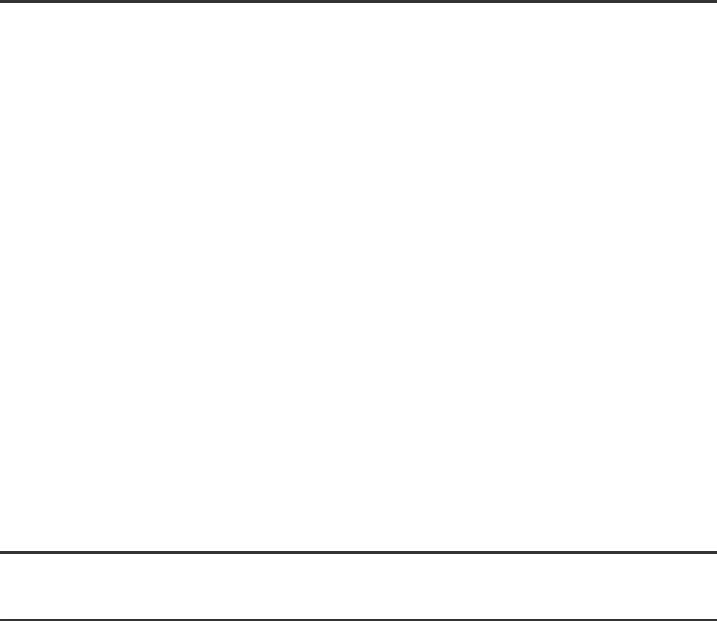
Gas and Electric Dryer Installation Instructions
29" Wide Models
Instructions d’installation de la sécheuse à gaz et électrique Modèles de largeur 29"
Table of Contents |
Table des matières |
DRYER SAFETY........................................................................... |
2 |
INSTALLATION REQUIREMENTS.............................................. |
4 |
Tools and Parts.................................................................... |
4 |
Location Requirements....................................................... |
5 |
ELECTRICAL REQUIREMENTS – U.S.A. ONLY |
|
(SPÉCIFICATIONS ÉLECTRIQUES – ÉTATS-UNIS |
|
SEULEMENT)............................................................................... |
7 |
Electrical Requirements...................................................... |
7 |
ELECTRIC DRYER POWER HOOKUP – CANADA ONLY......... |
8 |
Electrical Requirements...................................................... |
8 |
GAS DRYER POWER HOOKUP – U.S.A. AND CANADA.......... |
8 |
Electrical Requirements...................................................... |
8 |
Gas Supply Requirements................................................... |
9 |
Install Leveling Legs.......................................................... |
10 |
MAKE ELECTRICAL CONNECTION – U.S.A. ONLY |
|
(EFFECTUER LE RACCORDEMENT ÉLECTRIQUE – |
|
ÉTATS-UNIS SEULEMENT)....................................................... |
11 |
Electrical Connection Options.......................................... |
11 |
Power Supply Cord Connection....................................... |
12 |
Direct Wire Connection..................................................... |
13 |
MAKE GAS CONNECTION....................................................... |
16 |
VENTING.................................................................................... |
17 |
Venting Requirements....................................................... |
17 |
Plan Vent System............................................................... |
18 |
Venting Kits........................................................................ |
18 |
INSTALL VENT SYSTEM........................................................... |
19 |
CONNECT INLET HOSES......................................................... |
20 |
CONNECT VENT........................................................................ |
21 |
LEVEL DRYER........................................................................... |
21 |
COMPLETE INSTALLATION CHECKLIST................................ |
22 |
REVERSE DOOR SWING (OPTIONAL)..................................... |
22 |
TROUBLESHOOTING................................................................ |
24 |
SÉCURITÉ DE LA SÉCHEUSE.................................................. |
25 |
EXIGENCES D’INSTALLATION................................................. |
27 |
Outillage et pièces............................................................. |
27 |
Exigences d’emplacement................................................ |
28 |
RACCORDEMENT DE LA SÉCHEUSE ÉLECTRIQUE – |
|
CANADA SEULEMENT.............................................................. |
30 |
Spécifications électriques................................................. |
30 |
RACCORDEMENT D’UNE SÉCHEUSE À GAZ........................ |
31 |
Spécifications électriques................................................. |
31 |
Spécifications de l’alimentation en gaz........................... |
31 |
Installation des pieds de nivellement............................... |
33 |
Raccordement au gaz....................................................... |
33 |
ÉVACUATION............................................................................. |
34 |
Exigences concernant l’évacuation................................. |
34 |
Planification du système d’évacuation............................ |
35 |
Trousses d’évacuation....................................................... |
36 |
INSTALLATION DU CIRCUIT D’ÉVACUATION........................ |
37 |
RACCORDEMENT DES TUYAUX D’ALIMENTATION.............. |
37 |
RACCORDEMENT DU CONDUIT D’ÉVACUATION................. |
39 |
RÉGLAGE DE L’APLOMB DE LA SÉCHEUSE......................... |
39 |
ACHEVER L’INSTALLATION – LISTE DE VÉRIFICATION....... |
39 |
INVERSION DU SENS DE L’OUVERTURE DE LA PORTE |
|
(FACULTATIF)............................................................................. |
40 |
DÉPANNAGE.............................................................................. |
42 |
Para obtener acceso al manual de uso y cuidado en español, o para obtener información adicional acerca de su producto, visite: www.whirlpool.com o www.maytag.com
Tenga listo su número de modelo completo. Puede encontrar el número de modelo y de serie dentro de la cavidad superior de la puerta.
INSTALLATION NOTES |
NOTES CONCERNANT L’INSTALLATION |
Date of purchase:_________________________________ |
Date d’achat :_____________________________________ |
Date of installation:_ _______________________________ |
Date d’installation :_ ________________________________ |
Installer:_________________________________________ |
Installateur :_______________________________________ |
Model number:____________________________________ |
Numéro de modèle :_________________________________ |
Serial number:____________________________________ |
Numéro de série :___________________________________ |
W10848818A |
|
W10848821A-SP |
1 |
|
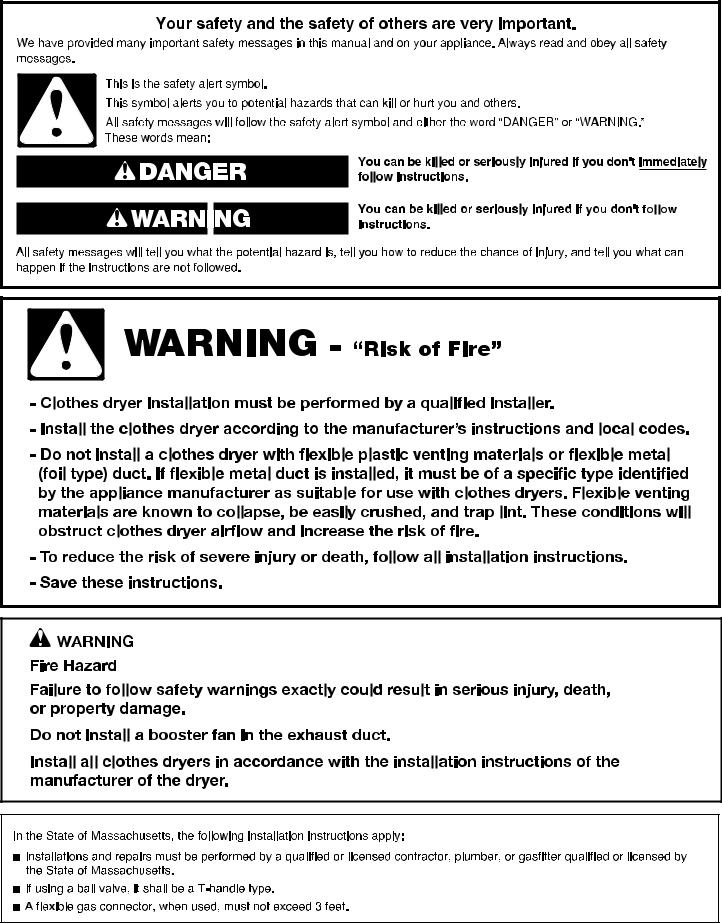
DRYER SAFETY
2
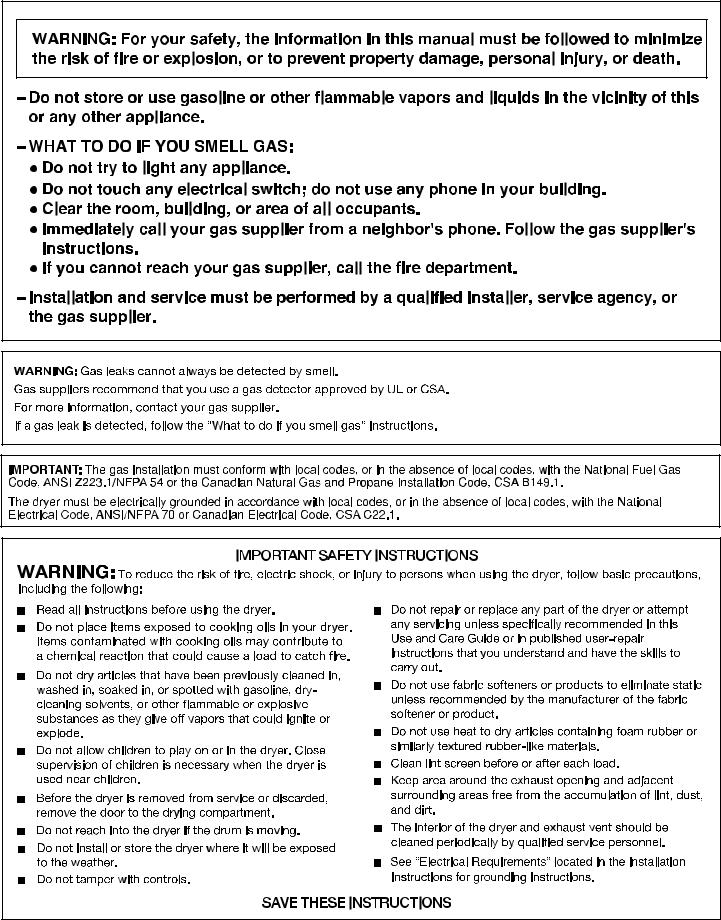
3
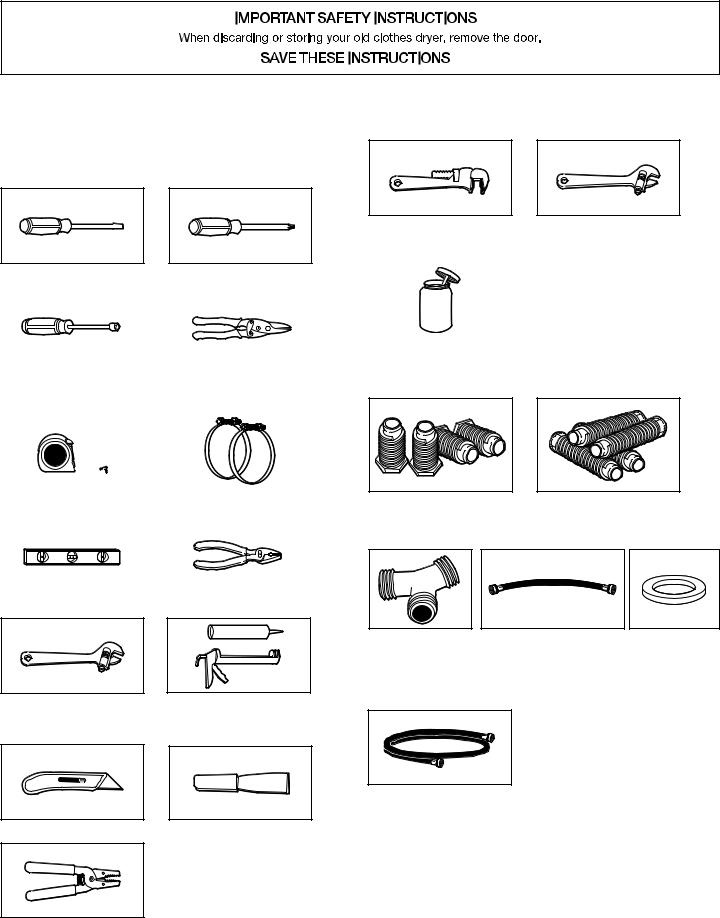
INSTALLATION REQUIREMENTS
Tools and Parts
Gather the required tools and parts before starting installation.
Tools needed for all installations:
Flat-blade screwdriver |
|
#2 Phillips screwdriver |
|
|
|
|
|
|
1/4" nut driver or socket |
|
Tin snips (new vent |
||||
wrench (recommended) |
|
installations) |
||||
|
|
|
|
|
|
|
|
|
|
|
|
|
|
|
|
|
|
|
|
|
Tape measure |
|
Vent clamps |
|
|
|
|
|
|
Tools needed for gas installations:
8" (203 mm) or 10" |
8" (203 mm) or 10" |
(254 mm) pipe wrench |
(254 mm) adjustable wrench |
|
(for gas connections) |
|
|
|
|
Pipe-joint compound resistant to LP gas
Parts supplied (all models):
or |
Leveling legs (4)
(Length and appearance of legs may vary according to model)
Parts supplied (steam models):
Level
Adjustable wrench that opens to 1" (25 mm) or hex-head socket wrench
Utility knife
Wire Stripper (direct wire installations)
Pliers
Caulking gun and compound (for installing new exhaust vent)
Putty knife
“Y” connector |
Short inlet hose |
Rubber washer |
Parts package is located in dryer drum. Check that all parts are included.
Parts needed (steam models):
5' (1.52 m) inlet hose
If using a power supply cord:
Use a UL listed power supply cord kit marked for use with clothes dryers. The kit should contain:
■■ A UL listed 30-amp power supply cord, rated 120/240 volt minimum. The cord should be type SRD or SRDT and be at least 4 ft. (1.22 m) long. The wires that connect to
the dryer must end in ring terminals or spade terminals with upturned ends.
■■ A UL listed strain relief.
4
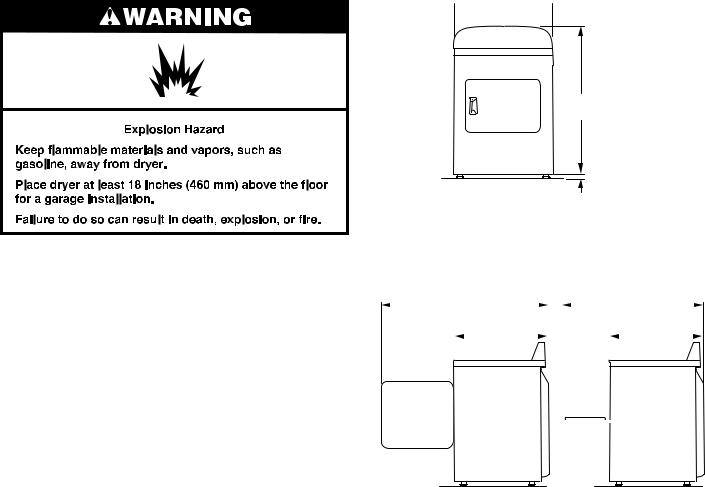
Parts needed: (Not supplied with dryer)
Check local codes. Check existing electrical supply and venting. See “Electrical Requirements” and “Venting Requirements” before purchasing parts.
Mobile home installations require metal exhaust system hardware available for purchase from the dealer from whom you purchased your dryer. For further information, please refer to the “Assistance or Service” section in your “Use and Care Guide.”
Optional Equipment: (Not supplied with dryer)
Refer to your “Use and Care Guide” for information about accessories available for your dryer.
Location Requirements
Installation clearances:
For each arrangement, consider allowing more space for ease of installation and servicing, spacing for companion appliances, and clearances for walls, doors, and floor moldings. Space must be large enough to allow door to fully open. Add spacing on all sides of dryer to reduce noise transfer. If a closet door or louvered door is installed, top and bottom air openings in door are required.
Check code requirements. Some codes limit, or do not permit, installation of the dryer in garages, closets, mobile homes, or sleeping quarters. Contact your local building inspector.
Dryer Dimensions
Front View
 29"
29"  (737 mm)
(737 mm)
407/8"
(1038 mm)
1/2"
(13 mm)
You will need:
■■ A location allowing for proper exhaust installation. See “Venting Requirements.”
■■ A separate 15 or 20-amp circuit needed for gas dryers and 30-amp circuit needed for electric dryers.
■■ If you are using power supply cord, a grounded electrical outlet located within 2 ft. (610 mm) of either side of dryer. See “Electrical Requirements.”
■■ A sturdy floor to support dryer and a total weight (dryer and load) of 200 lbs. (90.7 kg). The combined weight of a companion appliance should also be considered.
■■ Level floor with maximum slope of 1" (25 mm) under entire dryer. If slope is greater than 1" (25 mm), install Extended Dryer Feet Kit, Part Number 279810. If not level, clothes may not tumble properly and automatic sensor cycles may not operate correctly.
■■ For garage installation, place dryer at least 18" (460 mm) above floor.
■■ Steam models only: Cold water faucet located within 4 ft. (1.2 m) of the water fill valves, and water pressure of 20-100 psi (137.9-689.6 kPa). You may use the water supply for your washer using the “Y” connector and short hose which are provided.
IMPORTANT: Do not operate, install, or store dryer where it will be exposed to water, weather, or at temperatures below 45°F (7°C). Lower temperatures may cause dryer not to shut off at end of automatic sensor cycles, resulting in longer drying times.
NOTE: No other fuel-burning appliance can be installed in the same closet as a dryer.
NOTE: Minimum height of leveling legs should be 1/2" (13 mm), or to match the height of the accompanying washer.
Side View
|
503/4" |
|
|
|
|
|
|
|
|
|
|
|
|
|
|
|
|
|
42" |
|
|
|
|
|
|
|||||
(1289 mm) |
|
|
|
(1067 mm) |
||||||||||||||||||||||||||
|
|
|
281/4" |
|
|
|
|
|
|
|
|
|
|
281/4" |
|
|
|
|
||||||||||||
|
|
|
|
|
|
|
|
|
|
|
|
|
|
|
|
|||||||||||||||
|
|
|
|
|
|
|
|
|
|
|
|
|||||||||||||||||||
|
|
|
|
|
(717 mm) |
|
|
|
|
|
|
|
|
|
|
|
(717 mm) |
|||||||||||||
|
|
|
|
|
|
|
|
|
|
|
|
|
|
|
|
|
|
|
|
|
|
|
|
|
|
|
|
|
|
|
|
|
|
|
|
|
|
|
|
|
|
|
|
|
|
|
|
|
|
|
|
|
|
|
|
|
|
|
|
|
|
|
|
|
|
|
|
|
|
|
|
|
|
|
|
|
|
|
|
|
|
|
|
|
|
|
|
|
|
|
|
|
|
|
|
|
|
|
|
|
|
|
|
|
|
|
|
|
|
|
|
|
|
|
|
|
|
|
|
|
|
|
|
|
|
|
|
|
|
|
|
|
|
|
|
|
|
|
|
|
|
|
|
|
|
|
|
|
|
|
|
|
|
|
A B
A.Wide opening side-swing door
B.Wide opening hamper door
5
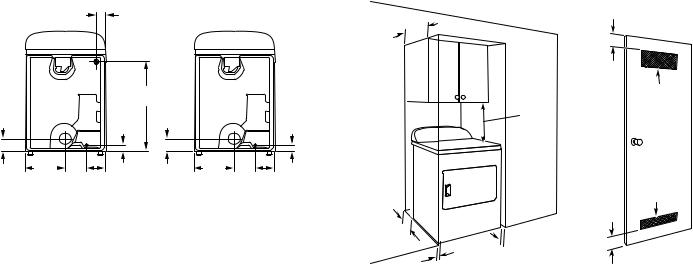
Back View
4" (101 mm)
301/4"
(768 mm)
11/4" |
11/4" |
(32 mm) |
(32 mm) |
43/4" |
141/2" |
91/4" |
43/4" |
141/2" |
91/4" |
(121 mm) (368 mm) |
(121 mm) |
(368 mm) |
|||
|
|
(235 mm) |
|
|
(235 mm) |
Steam |
Non-Steam |
Installation spacing for recessed area or closet
The dimensions shown are for the minimum spacing allowed.
■■ Additional spacing should be considered for ease of installation and servicing.
■■ Additional clearances might be required for wall, door, and floor moldings.
■■ Additional spacing of 1" (25 mm) on all sides of the dryer is recommended to reduce noise transfer.
■■ For closet installation, with a door, minimum ventilation openings in the top and bottom of the door are required. Louvered doors with equivalent ventilation openings are acceptable.
■■ Companion appliance spacing should also be considered.
Installation Spacing
14" max |
|
|
(356 mm) |
|
|
|
3"/3" |
|
|
(76 mm/ |
|
|
76mm) |
48"2/48"2 |
|
|
(310 cm2/ |
|
18"/18" |
310 cm2) |
|
(457 mm/ |
|
|
457 mm) |
|
|
|
24"2/24"2 |
|
|
(155 cm2/ |
|
3"/3" |
155 cm2) |
6"/0" |
(76 mm/ |
|
(152 mm/ |
76mm) |
|
0 mm) |
|
|
 1"/1"
1"/1"
(25 mm/25 mm)
1"/0"
(25 mm/0 mm)
Recommended/Minimum spacing
Mobile home – Additional installation requirements
This dryer is suitable for mobile home installations. The installation must conform to the Manufactured Home Construction and Safety Standard, Title 24 CFR, Part 3280 (formerly the Federal Standard for Mobile Home Construction and Safety, Title 24, HUD Part 280) or the Canadian Manufactured Home Standard CAN/CSA-Z240 MH.
■■ Metal exhaust system hardware, available for purchase. For further information, please reference the “Assistance or Service” section of the “Use and Care Guide.”
■■ Special provisions must be made in mobile homes to introduce outside air into the dryer. The opening (such as a nearby window) should be at least twice as large as the dryer exhaust opening.
For gas dryers mobile home installations:
■■ Mobile Home Installation Hold-down Kit Part Number W10432680 is available to order. For further information, see “Assistance or Service” section in your “Use and Care Guide.”
6

ELECTRICAL REQUIREMENTS – U.S.A. ONLY (SPÉCIFICATIONS ÉLECTRIQUES – ÉTATS-UNIS SEULEMENT)
Electrical Requirements
It is your responsibility:
■■ To contact a qualified electrical installer.
■■ To be sure that the electrical connection is adequate and in conformance with the National Electrical Code, ANSI/NFPA 70 - latest edition and all local codes and ordinances.
The National Electrical Code requires a 4-wire power supply connection for homes built after 1996, dryer circuits involved in remodeling after 1996, and all mobile home installations.
A copy of the above code standards can be obtained from: National Fire Protection Association, One Batterymarch Park, Quincy, MA 02269.
■■ To supply the required 3 or 4 wire, single phase, 120/240 volt, 60 Hz, AC only electrical supply (or 3 or 4 wire, 120/208 volt electrical supply, if specified on the serial/rating plate) on a separate 30-amp circuit, fused on both sides of the line. Connect to an individual branch circuit. Do not have
a fuse in the neutral or grounding circuit. ■■ Do not use an extension cord.
■■ If codes permit and a separate ground wire is used, it is recommended that a qualified electrician determine that the ground path is adequate.
Electrical Connection
To properly install your dryer, you must determine the type of electrical connection you will be using and follow the instructions provided for it here.
■■ This dryer is manufactured ready to install with a 3-wire electrical supply connection. The neutral ground conductor is permanently connected to the neutral conductor (white wire) within the dryer. If the dryer is installed with a 4-wire electrical supply connection, the neutral ground conductor must be removed from the external ground connector (green screw), and secured under the neutral terminal (center or white wire) of the terminal block. When the neutral ground conductor is secured under the neutral terminal (center
or white wire) of the terminal block, the dryer cabinet is isolated from the neutral conductor.
■■ If local codes do not permit the connection of a neutral ground wire to the neutral wire, see “Optional 3-wire connection” section.
■■ A 4-wire power supply connection must be used when the appliance is installed in a location where grounding through the neutral conductor is prohibited. Grounding through the neutral is prohibited for (1) new branch-circuit installations,
(2) mobile homes, (3) recreational vehicles, and (4) areas where local codes prohibit grounding through the neutral conductors.
If using a power supply cord:
Use a UL listed power supply cord kit marked for use with clothes dryers. The kit should contain:
■■ A UL listed 30-amp power supply cord, rated 120/240 volt minimum. The cord should be type SRD or SRDT and be at least 4 ft. (1.22 m) long. The wires that connect to
the dryer must end in ring terminals or spade terminals with upturned ends.
■■ A UL listed strain relief.
If your outlet looks like this:
|
|
|
|
|
Then choose a 4-wire power supply cord with |
|
|
|
|
|
ring or spade terminals and UL listed strain |
|
|
|
|
|
relief. The 4-wire power supply cord, at least |
|
|
|
|
|
|
|
|
|
|
|
4 ft. (1.22 m) long, must have 4 10-gauge solid |
|
|
|
|
|
|
|
|
|
|
|
copper wires and match a 4-wire receptacle of |
|
4-wire |
NEMA Type 14-30 R. The ground wire (ground |
|||
|
conductor) may be either green or bare. The |
||||
receptacle |
neutral conductor must be identified by a |
||||
(14-30R) |
white cover. |
||||
|
|
|
|
|
|
If your outlet looks like this:
Then choose a 3-wire power supply cord with ring or spade terminals and UL listed strain relief. The 3-wire power supply cord, at least 4 ft. (1.22 m) long, must have 3 10-gauge solid copper wires and match a 3-wire receptacle of NEMA Type 10-30R.
3-wire receptacle (10-30R)
If connecting by direct wire:
Power supply cable must match power supply (4-wire or 3-wire) and be:
■■ Flexible armored cable or nonmetallic sheathed copper cable (with ground wire), covered with flexible metallic conduit. All current-carrying wires must be insulated.
■■ 10-gauge solid copper wire (do not use aluminum) at least 5 ft. (1.52 m) long.
7
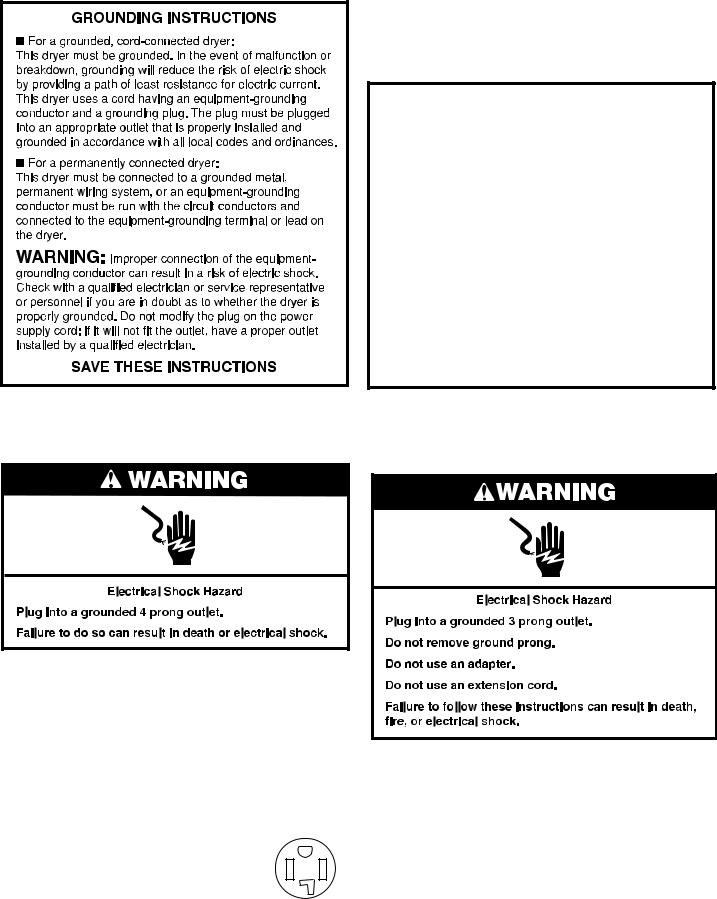
ELECTRIC DRYER POWER HOOKUP – CANADA ONLY
ELECTRICAL REQUIREMENTS
It is your responsibility:
■■ To contact a qualified electrical installer.
■■ To be sure that the electrical connection is adequate and in conformance with Canadian Electrical Code, C22.1-latest edition and all local codes. A copy of above codes standard may be obtained from: Canadian Standards Association, 178 Rexdale Blvd., Toronto, ON M9W 1R3 CANADA.
■■ To supply the required 4 wire, single phase, 120/240 volt, 60 Hz, AC only electrical supply on a separate 30-amp circuit, fused on both sides of the line. A time-delay fuse or circuit breaker is recommended. Connect to an individual branch circuit.
■■ This dryer is equipped with a CSA International Certified Power Cord intended to be plugged into a standard 14-30R wall receptacle. The cord is
5 ft. (1.52 m) long. Be sure wall receptacle
is within reach of dryer’s final location. 4-wire receptacle (14-30R)
If using a replacement power supply cord, it is recommended that you use Power Supply Cord Replacement Part Number 9831317.
For further information, please reference service numbers located in “Assistance or Service” section of your Use and Care Guide.
GROUNDING INSTRUCTIONS
■ For a grounded, cord-connected dryer:
This dryer must be grounded. In the event of malfunction or breakdown, grounding will reduce the risk of electric shock by providing a path of least resistance for electric current.
This dryer is equipped with a cord having an equipmentgrounding conductor and a grounding plug. The plug must be plugged into an appropriate outlet that is properly installed and grounded in accordance with all local codes and ordinances.
WARNING: Improper connection of the equipmentgrounding conductor can result in a risk of electric shock. Check with a quali•ed electrician or service representative or personnel if you are in doubt as to whether the dryer is properly grounded. Do not modify the plug provided with the dryer: if it will not •t the outlet, have a proper outlet installed by a quali•ed electrician.
SAVE THESE INSTRUCTIONS
GAS DRYER POWER HOOKUP – U.S.A. AND CANADA
ELECTRICAL REQUIREMENTS
■■ 120 Volt, 60 Hz, AC only, 15or 20-amp fused electrical supply is required. A time-delay fuse or circuit breaker is recommended. It is also recommended that a separate circuit serving only this dryer be provided.
8
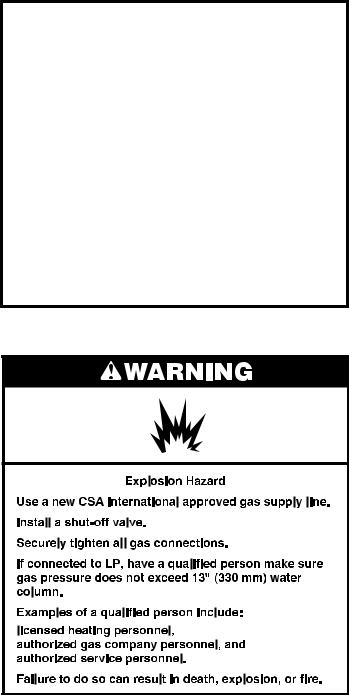
GROUNDING INSTRUCTIONS
■ For a grounded, cord-connected dryer:
This dryer must be grounded. In the event of malfunction or breakdown, grounding will reduce the risk of electric shock by providing a path of least resistance for electric current.
This dryer is equipped with a cord having an equipmentgrounding conductor and a grounding plug. The plug must be plugged into an appropriate outlet that is properly installed and grounded in accordance with all local codes and ordinances.
WARNING: Improper connection of the equipmentgrounding conductor can result in a risk of electric shock. Check with a quali•ed electrician or service representative or personnel if you are in doubt as to whether the dryer is properly grounded. Do not modify the plug provided with the dryer: if it will not •t the outlet, have a proper outlet installed by a quali•ed electrician.
SAVE THESE INSTRUCTIONS
Gas Supply Requirements
Gas type
Natural gas:
This dryer is equipped for use with Natural Gas. It is designcertified by CSA International for LP (propane or butane) gases with appropriate conversion.
■■ Your dryer must have the correct burner for the type of gas in your home. Burner information is located on the rating plate in the door well of your dryer. If this information does not agree with the type of gas available, please reference the “Assistance or Service” section of the Use and Care Guide.
LP Gas Conversion:
IMPORTANT: Conversion must be made by a qualified technician.
No attempt shall be made to convert the dryer from the gas specified on the model/serial rating plate for use with a different gas without consulting your gas company.
GAS SUPPLY LINE
Option 1 (Recommended Method)
Flexible stainless steel gas connector:
■■ If local codes permit, use a new flexible stainless steel gas connector (Design Certified by the American Gas Association or CSA International) to connect your dryer to the rigid
gas supply line. Use an elbow and a 3/8" flare x 3/8" NPT adapter fitting between the stainless steel gas connector and the dryer gas pipe, as needed, to prevent kinking.
Option 2 (Alternate Method)
Approved aluminum or copper tubing
■■ Must include 1/8" NPT minimum plugged tapping accessible for test gauge connection, immediately upstream of the gas connection to the dryer.
■■ 1/2" IPS pipe is recommended.
■■ 3/8" approved aluminum or copper tubing is acceptable for lengths under 20 ft. (6.1 m) if local codes and gas supplier permit.
■■ If you are using Natural gas, do not use copper tubing.
■■ Lengths over 20 ft. (6.1 m) should use larger tubing and a different size adapter fitting.
■■ If your dryer has been converted to use LP gas, 3/8" LP compatible copper tubing can be used. If the total length of the supply line is more than 20 ft. (6.1 m), use larger pipe.
NOTE: Pipe-joint compounds that resist the action of LP gas must be used. Do not use TEFLON®† tape.
■■ Must include shut-off valve
In the U.S.A.:
An individual manual shut-off valve must be installed within six (6) ft. (1.8 m) of the dryer in accordance with the National Fuel Gas Code, ANSI Z223.1. The location should be easy to reach for opening and closing.
In Canada:
An individual manual shut-off valve must be installed in accordance with the B149.1, Natural Gas and Propane Installation Code. It is recommended that an individual manual shutoff valve be installed within six (6) ft. (1.8 m) of the dryer. The location should be easy to reach for opening and closing.
†®TEFLON is a registered trademark of Chemours.
9
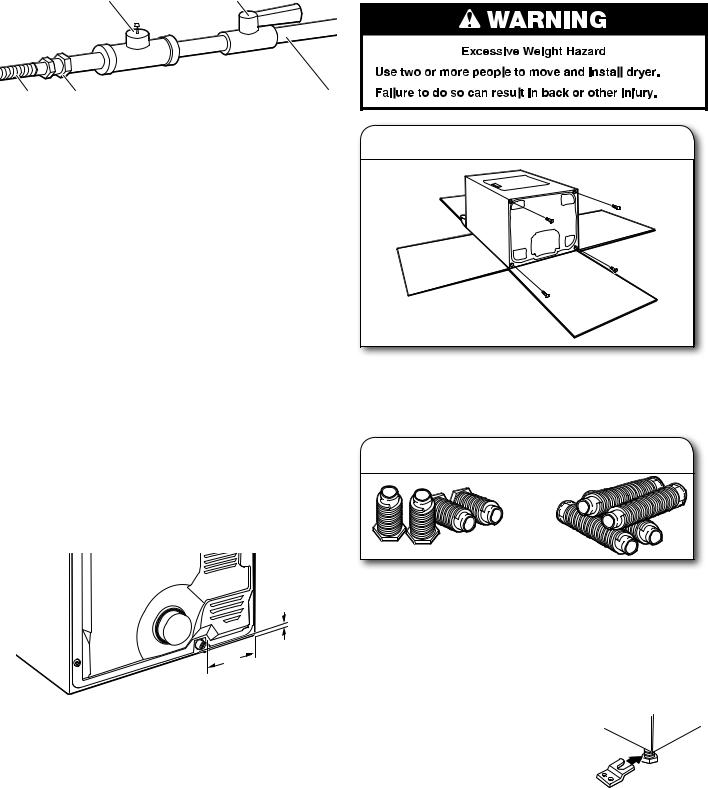
C E
INSTALL LEVELING LEGS
A B D
A.3/8" fl exible gas connector
B.3/8" pipe to fl are adapter fi tting
C.1/8" NPT minimum plugged tapping
D.1/2" NPT gas supply line
E.Gas shutoff valve
GAS SUPPLY CONNECTION REQUIREMENTS
■Use an elbow and a 3/8" fl are x 3/8" NPT adapter fi tting between the fl exible gas connector and the dryer gas pipe, as needed, to avoid kinking.
■Use only pipe-joint compound. Do not use TEFLON® tape.
■This dryer must be connected to the gas supply line with a listed fl exible gas connector that complies with the standard for connectors for gas appliances, ANSI Z21.24 or CSA 6.10.
BURNER INPUT REQUIREMENTS
Elevations above 2,000 ft. (610 m):
■When installed above 2,000 ft. (610 m), a 4% reduction of the burner Btu rating shown on the model/serial number plate is required for each 1,000 ft. (305 m) increase in elevation.
Gas supply pressure testing
■The dryer must be disconnected from the gas supply piping system during pressure testing at pressures greater than 1/2 psi.
Dryer gas pipe
■The gas pipe that comes out through the rear of your dryer has a 3/8" male pipe thread.
11/4"
(32 mm)
91/4"
(235 mm)
3/8" NPT dryer gas pipe
1. Prepare dryer for leveling legs
To avoid damaging fl oor, use a large, fl at piece of cardboard from dryer carton; place under entire back edge of dryer. Firmly grasp dryer body (not console panel) and gently lay dryer down on cardboard.
2. Screw in leveling legs
or |
Using a wrench and tape measure, screw leveling legs into leg holes until bottom of foot is approximately 1/2" (13 mm) from bottom of dryer (so that the dryer height matches that of the accompanying washer).
Now stand the dryer on its feet. Slide the dryer until it is close to its fi nal location. Leave enough room to connect the exhaust vent.
For mobile home use
Gas dryers must be securely fastened to the fl oor.
Mobile home installations require a Mobile Home Installation Hold-down Kit. For ordering information, please reference the “Use and Care Guide.”
10
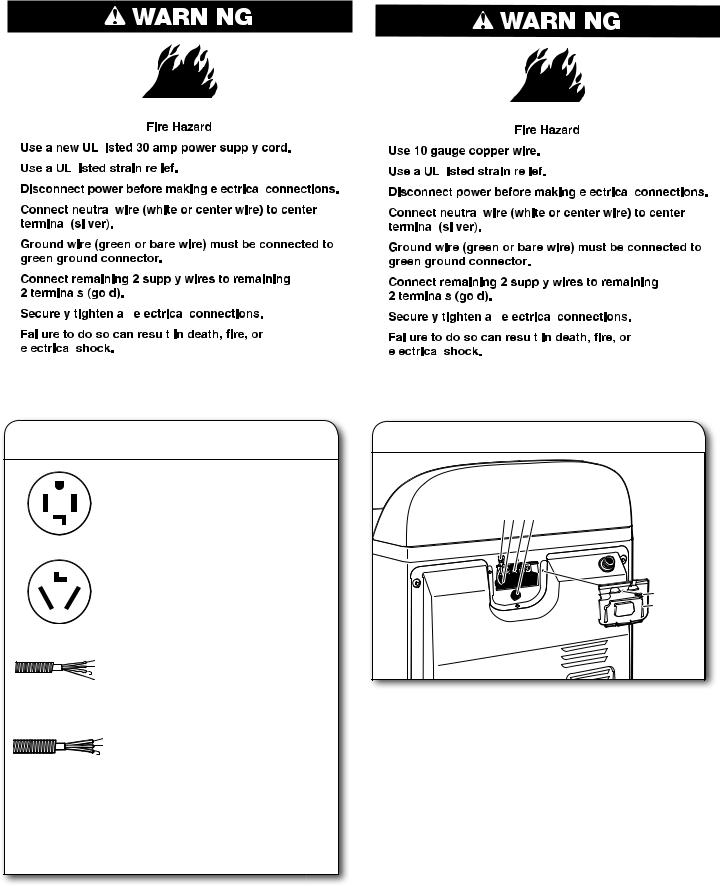
MAKE ELECTRICAL CONNECTION – U.S.A. ONLY (EFFECTUER LE RACCORDEMENT ÉLECTRIQUE – ÉTATS-UNIS SEULEMENT)
Power Supply Cord |
Direct Wire |
||||||||||||||||||||||||||||||||||||||||||
|
|
|
|
|
|
|
|
|
|
|
|
|
|
|
|
|
|
|
|
|
|
|
|
|
|
|
|
|
|
|
|
|
|
|
|
|
|
|
|
|
|
|
|
|
|
|
|
|
|
|
|
|
|
|
|
|
|
|
|
|
|
|
|
|
|
|
|
|
|
|
|
|
|
|
|
|
|
|
|
|
|
|
|
|
|
|
|
|
|
|
|
|
|
|
|
|
|
|
|
|
|
|
|
|
|
|
|
|
|
|
|
|
|
|
|
|
|
|
|
|
|
|
|
|
|
|
|
|
|
|
|
|
|
|
|
|
|
|
|
|
|
|
|
|
|
|
|
|
|
|
|
|
|
|
|
|
|
|
|
|
|
|
|
|
|
|
|
|
|
|
|
|
|
|
|
|
|
|
|
|
|
|
|
|
|
|
|
|
|
|
|
|
|
|
|
|
|
|
|
|
|
|
|
|
|
|
|
|
|
|
|
|
|
|
|
|
|
|
|
|
|
|
|
|
|
|
|
|
|
|
|
|
|
|
|
|
|
|
|
|
|
|
|
|
|
|
|
|
|
|
|
|
|
|
|
|
|
|
|
|
|
|
|
|
|
|
|
|
|
|
|
|
|
|
|
|
|
|
|
|
|
|
|
|
|
|
|
|
|
|
|
|
|
|
|
|
|
|
|
|
|
|
|
|
|
|
|
|
|
|
|
|
|
|
|
|
|
|
|
|
|
|
|
|
|
|
|
|
|
|
|
|
|
|
|
|
|
|
|
|
|
|
|
|
|
|
|
|
|
|
|
|
|
|
|
|
|
|
|
|
|
|
|
|
|
|
|
|
|
|
|
|
|
|
|
|
|
|
|
|
|
|
|
|
|
|
|
|
|
|
|
|
|
|
|
|
|
|
|
|
|
|
|
|
|
|
|
|
|
|
|
|
|
|
|
|
|
|
|
|
|
|
|
|
|
|
|
|
|
|
|
|
|
|
|
|
|
|
|
|
|
|
|
|
|
|
|
|
|
|
|
|
|
|
|
|
|
|
|
|
|
|
|
|
|
|
|
|
|
|
|
|
|
|
|
|
|
|
|
|
|
|
|
|
|
|
|
|
|
|
|
|
|
|
|
|
|
|
|
|
|
|
|
|
|
|
|
|
|
|
|
|
|
|
|
|
|
|
|
|
|
|
|
|
|
|
|
|
|
|
|
|
|
|
|
|
|
|
|
|
|
|
|
|
|
|
|
|
|
|
|
|
|
|
|
|
|
|
|
|
|
|
|
|
|
|
|
|
|
|
|
|
|
|
|
|
|
|
|
|
|
|
|
|
|
|
|
|
|
|
|
|
|
|
|
|
|
|
|
|
|
|
|
|
|
|
|
|
|
|
|
|
|
|
|
|
|
|
|
|
|
|
|
|
|
|
|
|
|
|
|
|
|
|
|
|
|
|
|
|
|
|
|
|
|
|
|
|
|
|
|
|
|
|
|
|
|
|
|
|
|
|
|
|
|
|
|
|
|
|
|
|
|
|
|
|
|
|
|
|
|
|
|
|
|
|
|
|
|
|
|
|
|
|
|
|
|
|
|
|
|
|
|
|
|
|
|
|
|
|
|
|
|
|
|
|
|
|
|
|
|
|
|
|
|
|
|
|
|
|
|
|
|
|
|
|
|
|
|
|
|
|
|
|
|
|
|
|
|
|
|
|
|
|
|
|
|
|
|
|
|
|
|
|
|
|
|
|
|
|
|
|
|
|
|
|
|
|
|
|
|
|
|
|
|
|
|
|
|
|
|
|
|
|
|
|
|
|
|
|
|
|
|
|
|
|
|
|
|
|
|
|
|
|
|
|
|
|
|
|
|
|
|
|
|
|
|
|
|
|
|
|
|
|
|
|
|
|
|
|
|
|
|
|
|
|
|
|
|
|
|
|
|
|
|
|
|
|
|
|
|
|
|
|
|
|
|
|
|
|
|
|
|
|
|
|
|
|
|
|
|
|
|
|
|
|
|
|
|
|
|
|
|
|
|
|
|
|
|
|
|
|
|
|
|
|
|
|
|
|
|
|
|
|
|
|
|
|
|
|
|
|
|
|
|
|
|
|
|
|
|
|
|
|
|
|
|
|
|
|
|
|
|
|
|
|
|
|
|
|
|
|
|
|
|
|
|
|
|
|
|
|
|
|
|
|
|
|
|
|
|
|
|
|
|
|
|
|
|
|
|
|
|
|
|
|
|
|
|
|
|
|
|
|
|
|
|
|
|
|
|
|
|
|
|
|
|
|
|
|
|
|
|
|
|
|
|
|
|
|
|
|
|
|
|
|
|
|
|
|
|
|
|
|
|
|
|
|
|
|
|
|
|
|
|
|
|
|
|
|
|
|
|
|
|
|
|
|
|
|
|
|
|
|
|
|
|
|
|
|
|
|
|
|
|
|
|
|
|
|
|
|
|
|
|
|
|
|
|
|
|
|
|
|
|
|
|
|
|
|
|
|
|
|
|
|
|
|
|
|
|
|
|
|
|
|
|
|
|
|
|
|
|
|
|
|
|
|
|
|
|
|
|
|
|
|
|
|
|
|
|
|
|
ELECTRICAL CONNECTION OPTIONS
1. Choose electrical connection type 2. Remove terminal block cover
Power supply cord 4-wire receptacle |
|
|
(NEMA Type 14-30R): Go to steps 1-2 |
|
|
on page 12 for power supply cord strain |
|
|
relief; then steps 3-6 for 4-wire Power |
B E C F |
|
Supply Cord Connection section. Then, |
|
|
go to Venting Requirements. |
|
|
Power supply cord 3-wire receptacle |
|
|
(NEMA Type 10-30R): Go to steps 1-2 |
|
|
on page 12 for power supply cord strain |
D |
|
relief; then steps 3-5 for 3-wire Power |
||
A |
||
Supply Cord Connection section. Then |
||
|
||
go to Venting Requirements. |
|
|
4-wire direct connection: Go to steps |
|
|
1-2 on page 13 for direct wire strain relief; |
|
|
then steps 3-8 for 4-wire Direct Wire |
|
|
Connection section. Then go to Venting |
|
|
Requirements. |
Before you start, disconnect power. Remove hold-down |
|
3-wire direct connection: Go to steps |
screw (D) and terminal block cover (A). |
|
|
||
1-2 on page 13 for direct wire strain relief; |
A. Terminal block cover |
|
then steps 3-7 for 3-wire Direct Wire |
B. External ground conductor screw |
|
Connection section. Then go to Venting |
C. Center terminal block screw |
|
Requirements. |
D. Hold-down screw |
|
|
E. Neutral ground wire |
|
NOTE: If local codes do not permit connection of a |
F. Hole below terminal block cover |
|
|
||
cabinet-ground conductor to neutral wire, go to “Optional |
|
|
3-wire Connection” section. This connection may be |
|
|
used with either a power supply cord or a direct wire |
|
|
connection. |
|
11
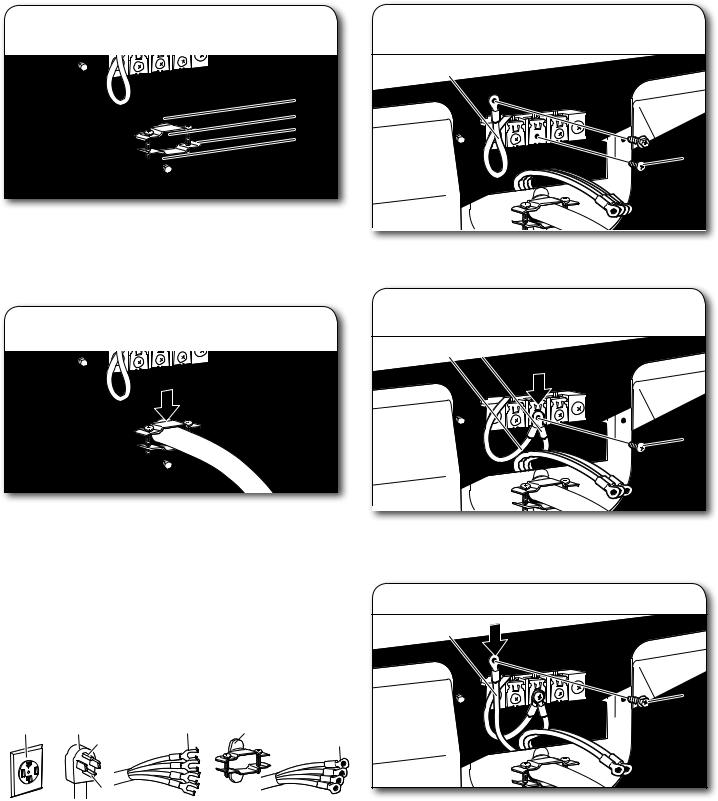
POWER SUPPLY CORD CONNECTION
Power supply cord strain relief
1. Attach power supply cord strain relief
A
B
C
D
Remove the screws from a 3/4" (19 mm) UL listed strain relief (UL marking on strain relief). Put the tabs of the two clamp sections (C) into the hole (B) below the terminal block opening so that one tab is pointing up (A) and the other is pointing down (D), and hold in place. Tighten strain relief screws just enough to hold the two clamp sections (C) together.
2. Attach power supply cord to strain relief
3. Prepare to connect neutral ground wire and neutral wire
E
 A
A
B
Remove center terminal block screw (B). Remove neutral ground wire (E) from external ground conductor screw (A).
4. Connect neutral ground wire and neutral wire
E C
B
Put power supply cord through the strain relief. Be sure that the wire insulation on the power supply cord is inside the strain relief. The strain relief should have a tight fi t with the dryer cabinet and be in a horizontal position. Do not further tighten strain relief screws at this point.
For 3-wire Power Supply Cord Connection, continue to step 3 on page 13.
For 4-wire Power Supply Cord Connection, continue to step 3 on this page.
4-wire Power Supply Cord Connection
IMPORTANT: A 4-wire connection is required for mobile homes and where local codes do not permit the use of 3-wire connections.
A. |
B. |
E. |
F. |
|
C. |
|
G. |
D. 
A.4-wire receptacle (NEMA type 14-30R)
B.4-prong plug
C.Ground prong
D.Neutral prong
E.Spade terminals with upturned ends
F.3/4" (19 mm) UL listed strain relief
G.Ring terminals
Connect neutral ground wire (E) and neutral wire (white or center) (C) of power supply cord under center terminal block screw (B). Tighten screw.
5. Connect ground wire
F
A |
Connect ground wire (F) (green or bare) of power supply cord to external ground conductor screw (A). Tighten screw.
12

6. Connect remaining wires |
5. Connect remaining wires |
Connect remaining wires to outer terminal block screws. Tighten screws. Finally, reinstall terminal block cover. Secure cover with hold-down screw. Now, go to Venting Requirements.
3-wire Power Supply Cord Connection
Use where local codes permit connecting cabinet-ground conductor to neutral wire.
A. |
B. |
C. |
D. |
G. |
F. |
|
|
|
|||
|
|
|
|
|
E.
A.3-wire receptacle (NEMA type 10-30R)
B.3-wire plug
C.Neutral prong
D.Spade terminals with upturned ends
E.3/4" (19 mm) UL listed strain relief
F.Ring terminals
G.Neutral (white or center wire)
3.Remove center screw
B
Remove center terminal block screw (B).
4. Connect neutral wire
C
B
Connect neutral wire (white or center) (C) of power supply cord to center terminal block screw (B). Tighten screw.
Connect remaining wires to outer terminal block screws. Tighten screws. Finally, reinstall terminal block cover. Secure cover with hold-down screw. Now, go to Venting Requirements.
DIRECT WIRE CONNECTION
Direct wire strain relief
1. Attach direct wire strain relief
A
B
C
Unscrew the removable conduit connector (A) and any screws from a 3/4" (19 mm) UL listed strain relief (UL marking on strain relief). Put the threaded section of the strain relief through the hole (B) below the terminal block opening. Reaching inside the terminal block opening, screw the removable conduit connector onto the strain relief threads (C).
2. Attach direct wire cable to strain relief
Put direct wire cable through the strain relief. The strain relief should have a tight fi t with the dryer cabinet and be in a horizontal position. Tighten strain relief screws.
For 3-wire Direct Wire Connection, continue to step 3 on page 15.
For 4-wire Direct Wire Connection, continue to step 3 on the next page.
13
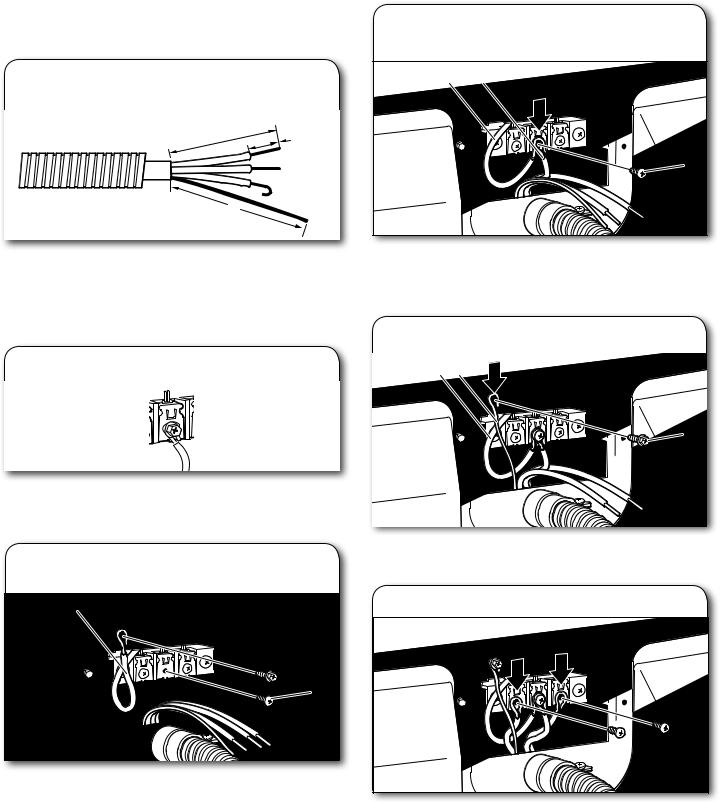
4-wire Direct Wire Connection
IMPORTANT: A 4-wire connection is required for mobile homes and where local codes do not permit 3-wire connections.
3. Prepare your 4-wire cable for direct connection
|
⁄2" |
|
|
||
1 |
|
|
|
||
3 |
|
mm) |
|
|
|
(89 |
1" |
||||
|
|||||
|
|
|
(25 |
mm) |
|
|
|
|
|
||
(127 |
5" |
|
mm) |
||
|
Direct wire cable must have 5 ft. (1.52 m) of extra length so dryer may be moved if needed.
Strip 5" (127 mm) of outer covering from end of cable, leaving bare ground wire at 5" (127 mm). Cut 11/2" (38 mm) from remaining 3 wires. Strip insulation back 1" (25 mm). Shape ends of wires into hooks.
4. Connect wires to terminal block
6. Connect neutral ground wire and neutral wire
E C
B
Connect neutral ground wire (E) and place hooked end (hook facing right) of neutral wire (white/center wire) (C) of direct wire cable under center screw of terminal block (B). Squeeze hooked ends together and tighten screw.
7. Connect ground wire
E F
To connect wires to terminal block, place hooked end of wire under terminal block screw, facing to the right, squeeze hooked end together, and tighten screw.
5. Prepare to connect neutral ground wire and neutral wire
E
 A
A
B
Remove center terminal block screw (B). Remove neutral ground wire (E) from external ground conductor screw (A).
A |
Connect ground wire (green or bare) (F) of direct wire cable to external ground conductor screw (A). Tighten screw.
8. Connect remaining wires
Place hooked ends of remaining direct wire cable wires under outer terminal block screws (hooks facing right). Squeeze hooked ends together and tighten screws. Finally, reinstall terminal block cover. Now, go to Venting Requirements.
14
